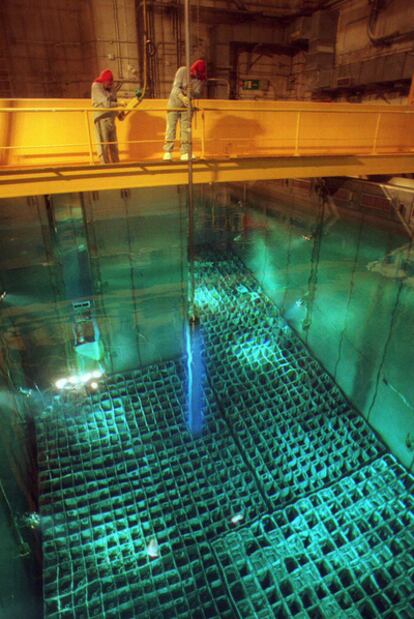Spain's half-forgotten search for a long-term nuclear waste solution
Some of country's spent fuel was sent to French plant hit by explosion
Radioactive waste remains a partially unresolved problem in Spain. Intermediate-level, low-level and very low-level waste - whose activity drops by half within 30 years - is sent to a facility at El Cabril, in Córdoba, but the issue of spent fuel from nuclear power plants has yet to be adequately addressed.
For now, each of Spain's six operating power stations stores its own waste. Some of it even ends up in France; the waste produced from the decommissioning of the Vandellòs I plant in Catalonia was sent to the southeastern French nuclear site of Marcoule - the same one where a furnace for treating low-level waste exploded on Monday, killing one worker and injuring several others.
The waste that is treated at El Cabril comes mostly from Spanish nuclear power plants, although the site also stores medical material and waste from hospitals, research centers and certain industrial sectors. Its history as a waste storage facility began in 1961, when the Nuclear Energy Commission started taking drums of radioactive waste there to store them in a uranium mine.
Low and very low-level waste can occasionally be incinerated, either to reduce its volume before storage or as a final treatment solution. But the real headache is posed by high-level waste management, including spent fuel from nuclear power plants, which remain radioactive for thousands of years.
In the more than 40 years that Spain has had nuclear technology, nobody has come up with a solution for at least the next 100 years. In the early 1980s, spent fuel from Santa María de Garoña, Burgos province, was sent to Britain. In 1989, when a fire led to the shutdown of Vandellòs I (Tarragona), the residue was dispatched to France, since Spain lacked a disposal facility. That particular shipment - 13 cubic meters of high-level waste and 665 cubic meters of intermediate-level waste - should have returned to Spain this year, but in two decades no government has been able to build a unified storage site to keep all of Spain's discarded radioactive material. A year ago, Prime Minister José Luis Rodríguez Zapatero made a public request for volunteer municipalities willing to play host to a storage facility for the next 70 years.
At the present time, each nuclear plant stores its own waste. Most facilities keep it inside spent fuel pools that are permanently cooled. But because these pools are saturated, the National Radioactive Waste Company (Enresa) has been building individual dry storage areas in Trillo and Zorita (Guadalajara) and is completing another one at Ascó (Tarragona).
In 2009, the Industry Ministry said it was extending Garoña's operating license until 2013 because that was the time that was needed to build a single nuclear storage site to take care of its radioactive waste. But two years have passed since then, and the storage site selection process remains forgotten in a drawer.
It is not a problem of volume, since all high-level waste put together would only take up 12,800 cubic meters, or 1/100th of the size of Santiago Bernabéu stadium, home to Real Madrid. It is simply a matter of political will.
The municipal and regional elections of May 22 provided support for the mayors who had volunteered to host a nuclear storage site, since all of them were reelected. Meanwhile, towns closest to nuclear power stations are demanding that the spent fuel pools be emptied out as soon as possible. They claim that the accident in Fukushima has proven the vulnerability of this type of facility. But environmentalists oppose building any storage site at all until a calendar for phasing out nuclear energy in Spain is produced.

Tu suscripción se está usando en otro dispositivo
¿Quieres añadir otro usuario a tu suscripción?
Si continúas leyendo en este dispositivo, no se podrá leer en el otro.
FlechaTu suscripción se está usando en otro dispositivo y solo puedes acceder a EL PAÍS desde un dispositivo a la vez.
Si quieres compartir tu cuenta, cambia tu suscripción a la modalidad Premium, así podrás añadir otro usuario. Cada uno accederá con su propia cuenta de email, lo que os permitirá personalizar vuestra experiencia en EL PAÍS.
¿Tienes una suscripción de empresa? Accede aquí para contratar más cuentas.
En el caso de no saber quién está usando tu cuenta, te recomendamos cambiar tu contraseña aquí.
Si decides continuar compartiendo tu cuenta, este mensaje se mostrará en tu dispositivo y en el de la otra persona que está usando tu cuenta de forma indefinida, afectando a tu experiencia de lectura. Puedes consultar aquí los términos y condiciones de la suscripción digital.








































